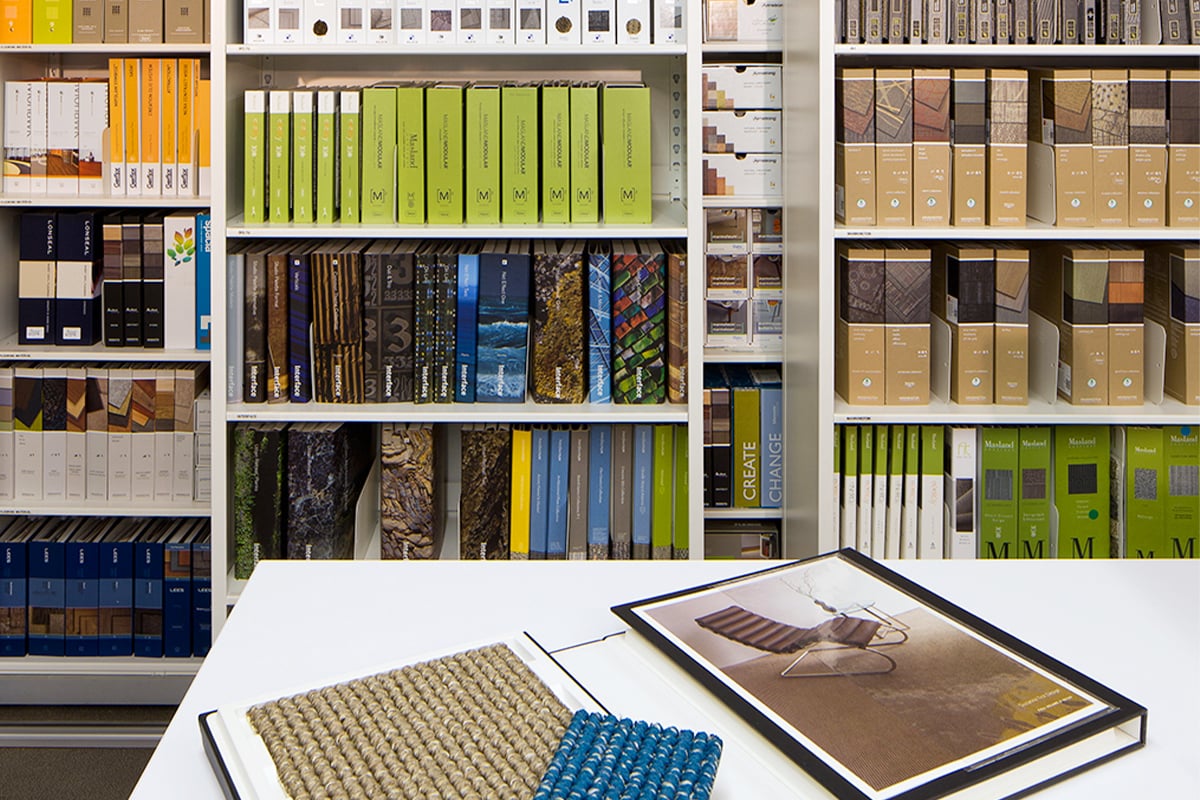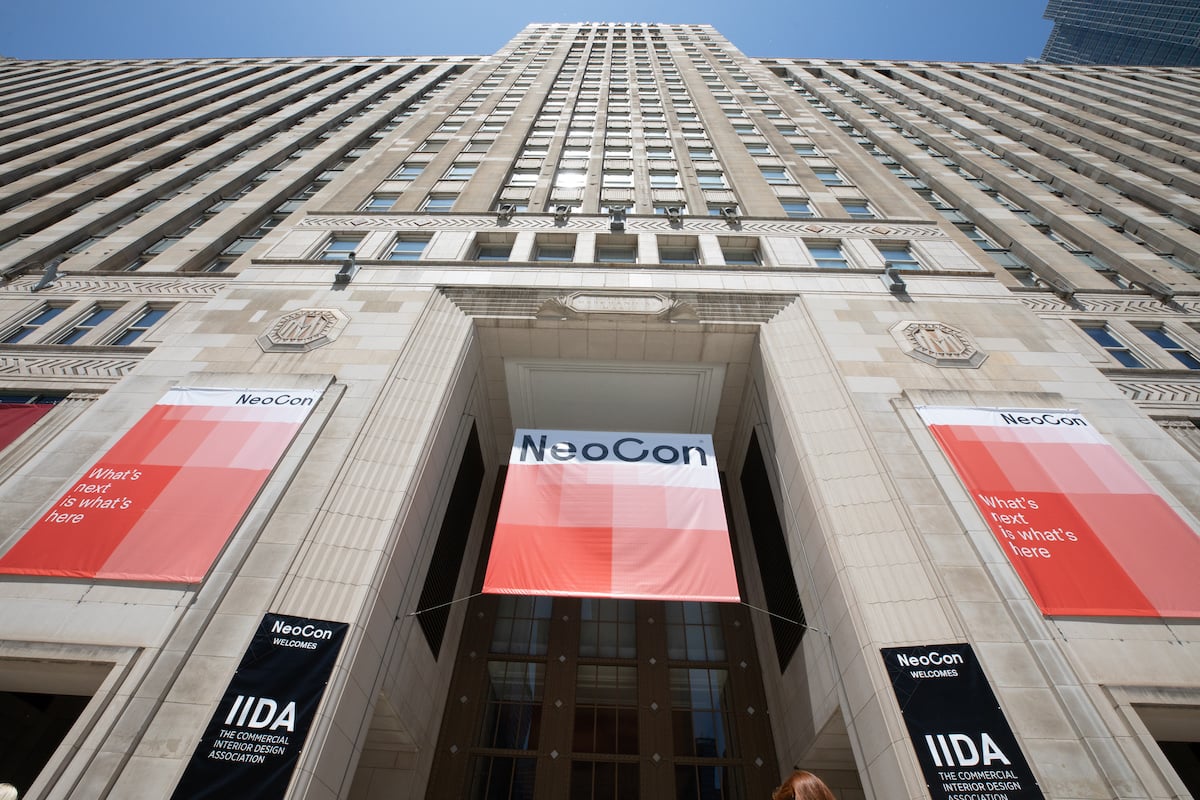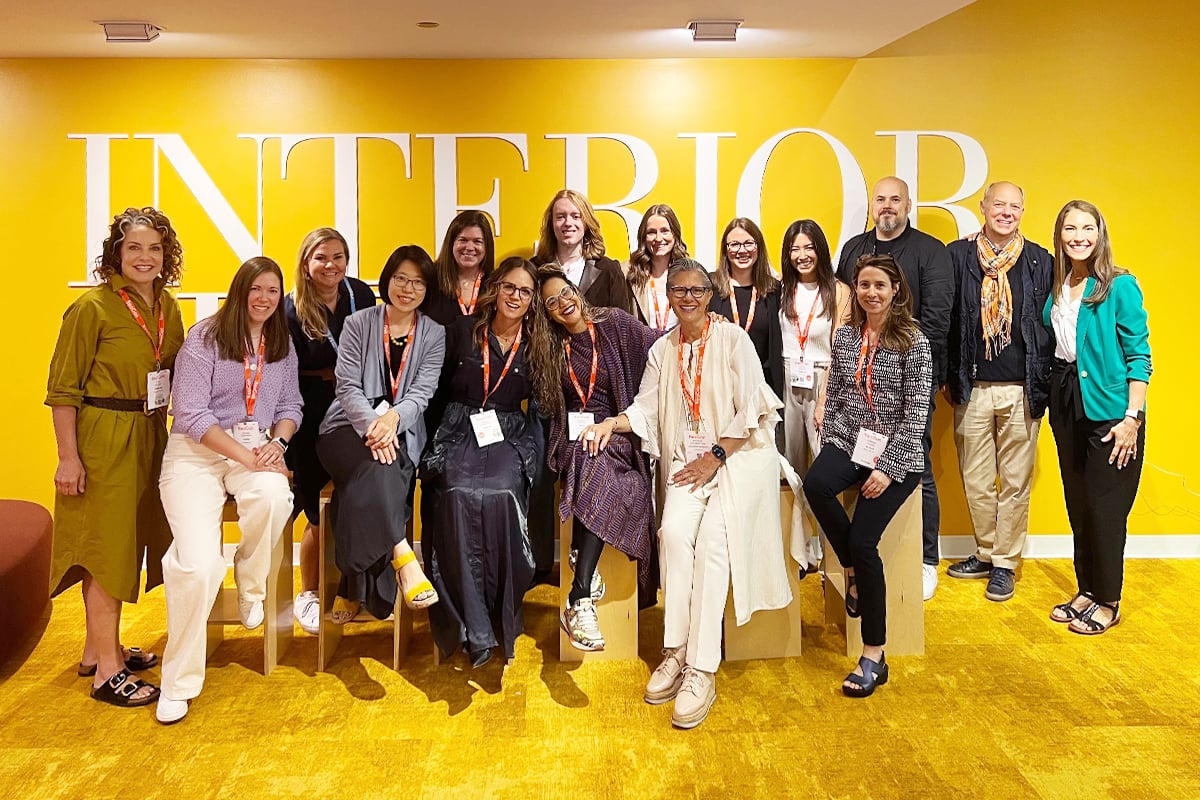
Many groups are curious about what the future holds for the architecture and design firm library.
A&D firms are trying to discover how to make optimal use of space and resources.
Manufacturers are gauging investments in physical and digital marketing materials.
Reps and service providers are trying to navigate a new world of social norms for schedules and presentations.
Regardless of your role, we’re sharing tangible ideas and stories that can shape your approach.
In season 3 of ThinkLab’s Design Nerds Anonymous podcast, we explored the future of the library with two designers from our 2022 Interior Design Giants of Design firms: NELSON (#8) and Ankrom Moisan (#91). They take two very different, yet equally innovative approaches, but by the end of the episode, you hear how well their goals align.
In this article, we explore a story from yet another Giant of Design: Interior Architects (IA – #6). What fascinated us most was not only how the firm is approaching the library, but also who is staffing.
Run by two confident Gen Z designers in the Chicago office, Grace Gadow and Catherine O’Brien, IA’s library is pushing us all to consider lasting change in response to new ways of hybrid working.
“A big thing we are battling is the automatic flip back to ‘the Before.’ That mindset flips quickly. Everyone’s looking forward to being back in person, but many others are still working hybrid. We are aware that if we just flip back, we are leaving behind team members.”
Here's how Interior Architects’ Chicago studio is revamping their approach to the A&D library:
A fresh perspective to the design world.
It is fully staffed by two Gen Z designers, bringing in a new perspective.
When Gadow and O’Brien joined IA, COVID-19 had shut everything down. On the first day they were physically at IA’s Chicago office, a mentor, John Hopkins, asked if they wanted to run the library. Gadow recalls, “The whole firm Chicago office was truly open to our take on the world reopening: What should stay? How do we reopen and leverage this as a tool to help our teams connect with one another and product options?”
Another major goal for Gadow and O’Brien was to expand accessibility to what O’Brien calls “community knowledge” in the firm. “How do we take that knowledge and document it so it is easily grabbable?” O’Brien asks. The two designers refer to pre-COVID-19 times as “the Before” (very Stranger Things, amiright?!) and want to move the industry forward now. O’Brien notes, “We have grown up with tech as Gen Z. Everything is really accessible and easy to compare information. Our industry still feels so tedious. We want to find a better way.”
But perhaps most importantly, even as Gen Z designers, they believe putting everything online doesn’t feel genuine: Marrying physical and digital is their core challenge.
How everything is geographically connected.
Chicago, a well-connected market, is the central hub of information for all of IA’s 22 offices.
Gadow explains that the Chicago office is the home of one of the largest IA libraries, and due to rep staffing, it’s more physically connected to the local culture: “There’s simply more accessibility. As part of the internal culture, Chicago has been core to IA. In looking at all of that through a post-COVID-19 lens, we asked ourselves, ‘How can we leverage this to connect even more? How do we connect with the other IA library leaders as they take on the world-reopening piece?’
Gadow and O’Brien facilitate communication across all offices, meeting with local reps, scheduling (typically hybrid) internal events/presentations, updating their internal digital database of information, and sharing it through a companywide newsletter.
Both are very aware of the current structure around rep territories. But they challenge that manufacturers may need to rethink as our world gets increasingly connected. “My ears are always open to the other locations reps serve and how other offices can benefit,” Gadow shares. “If a brand has a big presence in LA, that’s not lost on us. We have big offices out there. We have team members that are connected from other offices. Making the experience more equitable is our end goal.”
A new hybrid world.
It is optimized for hybrid communication through easily accessible digital tools.
The duo’s priority is creating a hybrid library that works for everyone: “We do have designers that are fully remote. How do we make sure we are not leaving them out?” O’Brien asks. She wonders which product categories are better suited for virtual presentations. “Since this was not considered an option in the past, we are all exploring it for the first time. You can’t replace the touch and feel of fabric in a virtual presentation, but even for the in-person presentations, we had to ask ourselves, ‘How can we archive that to make it available for others that couldn’t physically be there?’”
Their main solution is a digital database in Miro, featuring a chronological catalog of new releases with links, organized by product vertical (textiles, furniture, etc.), that is easily accessible any time of day in-office and remotely.
As for what documentation Gadow would love to see from reps, she says, “Ideally, we’d get a PDF with links to access Revit files, the sustainability story, a digital look book, and the rep has personally called out specific pieces that would work for us. We love to hear what’s new, and we love to hear what the rep’s favorite products are.” Gadow shares how one local rep, Stack Brogan, recently highlighted not only what was new but also gave useful information about what had been specified in past years and how it’s been enhanced recently.
But with any new material, they will need to consider both the physical and the digital. Gadow shares, “As we look to refresh our systems, my brain is looking at, ‘How do we get the fans of wallcoverings paint and not all the binders of cutsheets?’ Some have never been pulled.” This also means leveraging digital tools — especially with the goal of reducing waste. Gadow says, “Gone are the days where we order 100 samples. We leverage digital tools to filter first. Material Bank does a great job with sending stuff out clean, and returns. So, we are constantly asking, ‘How do we push our designers to think in digital ways?’”
A new efficient process.
New processes leverage the best of in-person and digital options to streamline rep and designer time.
O’Brien shares that one of their main goals was to streamline approaches across the board: “What is the best way to get this information across? Is a quick morning presentation enough, or do we need a longer lunch-hour presentation? How do we make sure the reps are giving our studio the best information in the best way that allows our designers to save time? We don’t have to do it the same old way.”
Gadow adds, “We were librarians for a month before we learned the very tedious scheduling process. We thought, ‘There has to be a better way!’”
Their solution was to give reps more autonomy by leveraging an electronic tool called Microsoft Bookings. Gadow continues, “We made a conscious effort to put the ball in the rep’s court. We send the link, and they book their own slot based on what is open.” As a result,
O’Brien has “noticed a new, refreshing take that is more informal. Let’s not sit for an hour while I talk at you. How can we make sure we are asking what the team is looking for? Checking chat if the virtual team has asked a question? We want to appreciate the old ways of doing things, but also evolve them to be more efficient for everyone.”
Another area for improvement is how to compare the sustainability story. They find that too many reps are ill-equipped to make products easy to compare. “Not only is this important to our firm, but as Gen Z designers, we don’t have the choice to not care,” O’Brien says. “We have no time left to make poor decisions. When the sustainability story falls flat, we tend to veer away from those manufacturers. It’s a red flag.”
The industry is constantly evolving.
A beta test mindset of constant analysis, testing, reframing, and testing again will create lasting change.
“We were joking with our ops manager,” O’Brien shares. “Every librarian wants to do something different. But we had this great opportunity to make a lasting impact.” She finds it both challenging and exciting “to see how we can push ourselves, our studio, and our reps to create the best-functioning library.”
Gadow adds, “We have to keep our innovative hat on. For example, I am still not convinced Miro is the best tool. How do we streamline more? This is working, but let’s question everything.” Their approach involves constantly optimizing. “This is why we haven’t scheduled out our fall,” she explains. “We are resetting with the team to make sure we are scheduling who they want to see. We are not tied to anything we have done in the past if there’s an easier way to get the same value-add.”
Gadow believes that being Gen Z-ers has given them certain advantages: “We have grown up forward- thinking, problem-solving in practical ways. We are in a good position to innovate. Who knows where the world will be in five years, but I hope we are putting in foundational pieces to move us forward. This is a change moment for a lot of things in the world. We are choosing to put that lens on the library.”
Want more on this topic? Listen to the podcast: The Future of the A&D Firm Library
Amanda Schneider is President of ThinkLab, the research division of SANDOW. At ThinkLab, we combine SANDOW Media’s incredible reach to the architecture and design community through brands like Interior Design Media, Metropolis, and Material Bank with proven market research techniques to uncover relevant trends and opportunities for the design industry. Join in to explore what’s next at thinklab.design/join-in.


